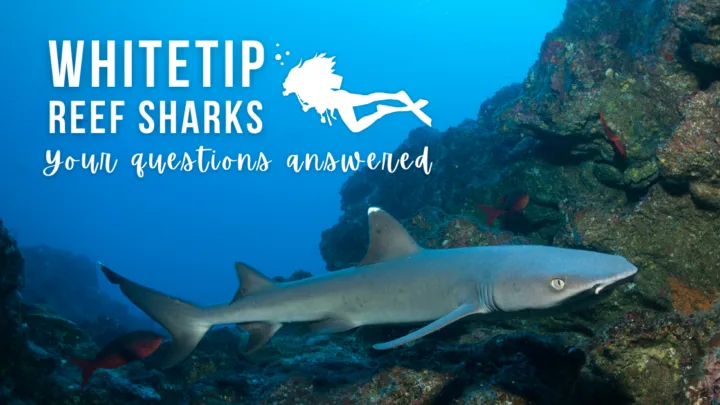Whitetip reef sharks, also known as Triaenodon obesus, can be found in coral reefs around the world. They are thought to have roamed the seas for an astonishing 42 million years.
Whitetip reef sharks are considered as guardian spirits (aumakua) by some Hawaiian cultures, and they’re a firm favourite among many scuba divers. But why are they so popular? If you’ve ever wondered what whitetip reef sharks eat, asked if reef sharks are dangerous, or how you can identify a whitetip reef shark, we’re here to answer your questions.
Let’s take a closer look at what sets these special creatures apart from the rest of their finned friends. Here are some whitetip reef shark facts you might not have known!
How can I identify a whitetip reef shark?
As much as most seasoned scuba divers love hanging out with sharks, the first time you come face-to-face with one in the water can be a little spooky. This is especially true if you don’t know what kind of shark you’re looking at.
Luckily, whitetip reef sharks are one of the easiest sharks to identify underwater… thanks to their white tips! Each whitetip reef shark has two white tips. There is one on their first dorsal fin, which is the easiest to spot, and one on the caudal (tail) fin.
But whitetip reef sharks aren’t the only sharks out there with pale tips on their fins. Oceanic whitetip sharks and silvertip sharks also have similar coloured dorsal fins. So, how can you be sure that you’re looking at a whitetip?
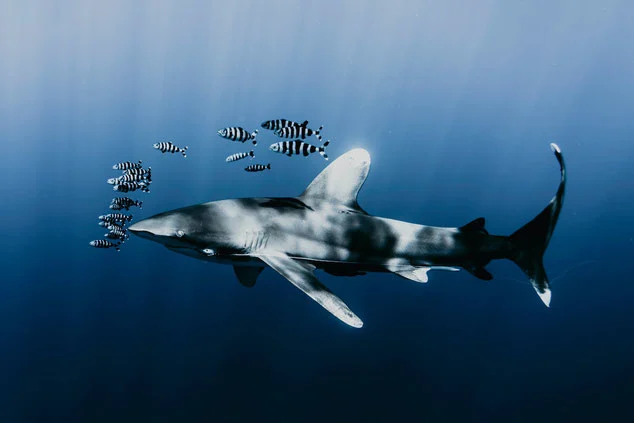
Whitetip reef sharks have a far more ‘fishy’ appearance than most people expect. They’re rarely longer than 1.5m. The heaviest whitetip ever recorded weighed just over 40 lbs – less than half of the heaviest salmons ever caught!
In contrast, oceanic whitetips can weigh as much as 350 lbs, giving them a stockier appearance. On top of that, their unique dorsal fins are large and curved, making oceanic whitetips very easy to distinguish.
Although silvertip sharks are also fairly slim, they have additional pale tips at the edge of their pectoral fins (the ones fish use to swim) that easily set them apart. Plus, they’re typically longer, with an average length of 2 to 2.5m.

So, next time you find yourself swimming alongside a shark with a white tip, ask yourself these questions? Is it small, slim and friendly looking? Does it have a pointed, white-tipped dorsal fin? Is it missing white tips on its pectoral fins?
If the answer to all of these questions is yes, you’re most likely looking at a whitetip reef shark!
What do whitetip reef sharks eat?
There’s a good reason for why whitetip reef sharks are so slender. They feed on creatures like octopus, small bony fish and crustaceans that hide away in small holes and crevices. And no, humans aren’t on the menu!
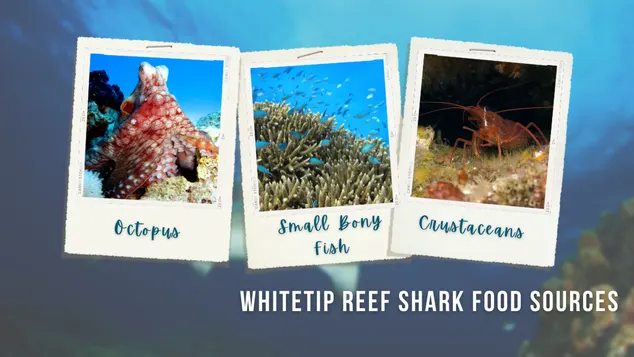
Having a slim, elongated body allows whitetip reef sharks to wiggle into these tight spaces when it’s time for them to feed. This is nearly always during the night.
What eats reef sharks?
On the flipside, their small size makes them ideal prey for larger fish, including tiger sharks and even giant grouper. This is why you’ll often find whitetip reef sharks, especially the small ones, hiding in caves and undercuts.
Why do whitetip reef sharks lie on the floor?
Whitetip reef sharks belong to the Carcharhinidae family, alongside heaps of other species. This includes blue sharks, tiger sharks, blacktip reef sharks and silky sharks, just to name a few.
Members of this family are also called requiem sharks. One of their defining features is that they must constantly move to breathe. This motion keeps the water running through the gills, providing critical oxygen.
Whitetips, however, have developed inner pumps that ensure a constant flow of water over the gills, even when they’re totally still. This means that whitetip reef sharks can afford the luxury of sitting still on the seabed.
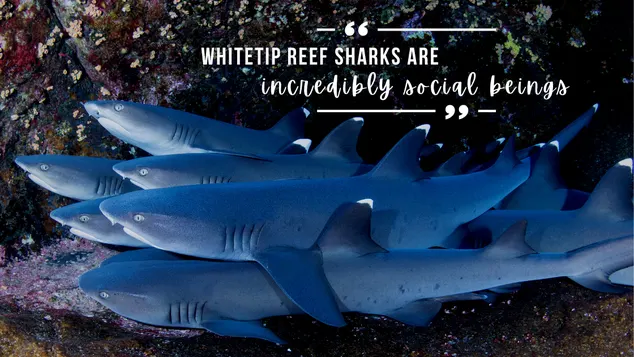
Their nocturnal feeding habits mean that whitetips are generally pretty tired during the day, so you’ll often spot them hanging out on the ocean floor, getting some R&R. In fact, whitetip reef sharks are incredibly social beings, and it’s not uncommon to see packs of up to 20 simply piled up on top of each other catching some Zs!
Are white tip reef sharks dangerous?
If you are lucky enough to spot a whitetip reef shark on the move, it’s likely to come and say hello – but should you worry about your new curious friend?
Nope! Their relaxed, friendly nature makes whitetip reef sharks an ideal species to observe under water, and they aren’t considered aggressive towards humans.
In fact, the International Shark Attack File, which has tried to record every single shark attack on humans since way back in 1580, doesn’t have a single record of a fatal attack by a whitetip reef shark. EVER. Similarly, this resource on shark attacks in Florida shows only one recorded whitetip shark attack.
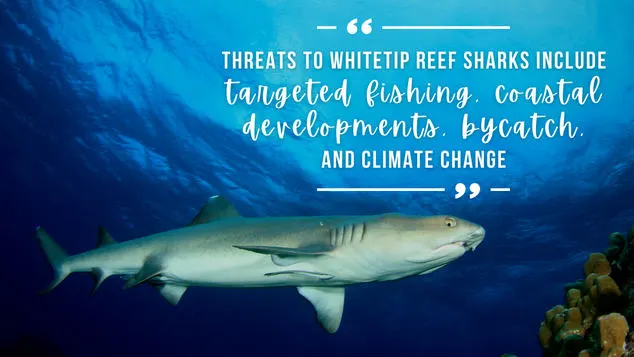
Tragically, the reverse isn’t true. Human activity (targeted fishing, coastal developments and by-catch, just to name a few), combined with climate change, is causing global whitetip reef shark numbers to decline.
The International Union for Conservation of Nature (commonly referred to as the IUCN) declared whitetip reef sharks as vulnerable to extinction in 2020.
How do whitetip reef sharks reproduce?
Mating can be a fairly hectic experience – there are often several males in pursuit of a single female! After fertilisation, the gestation period (pregnancy) lasts for roughly 12 months.
The females then typically give birth to litters of 2–3 fully capable pups, give or take a few! The pups are miniature versions of their parents, typically 60cm in length, and are left to fend for themselves.
Although whitetip reef sharks can live up to 25 years, they don’t typically reach sexual maturity until they’re 8 years old. Sadly, this relatively late development is making it even harder for whitetip reef shark populations to bounce back. If they’re killed before they’re 8 years old, then the numbers just can’t increase.
Where can I dive with whitetip reef sharks?
We hope that by now you’re as excited to scuba with these curious critters as we are – so where should you head to find them?
The clue is in the name really – the reef! More specifically, in caves, ledges, and under large corals, although the larger ones will sometimes be on the open seabed. Whitetip reef sharks can be found among reefs across the entire Indo-Pacific, so you don’t need to book any specialist trips to dive with them.
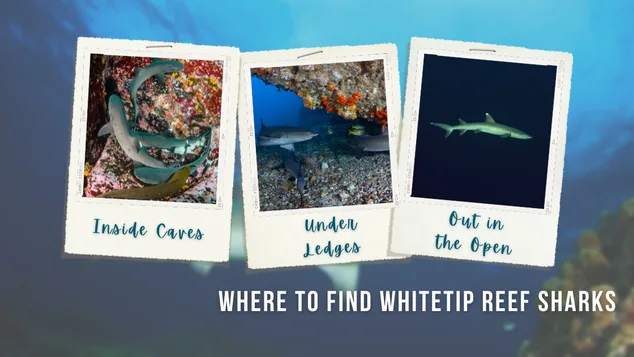
Because most reef-building corals are found in fairly shallow water, you’ll rarely see a whitetip any deeper than 40m. They’re usually found much shallower, although they have been known to go as deep as 330m on occasion! This is great news for Open Water divers, as you can often spot them at less than 18m.
Interestingly, whitetip reef sharks are also ‘nesters’. This means they tend to hang out in spots clustered in a single area, and it can be as small as 0.5km.
They’re also likely to return to the same hang-out spots for weeks, months, and even years, becoming semi-permanent features of the neighbourhood. So, if you’re diving in the same spot regularly, you might start to recognise some familiar faces over time!
How can I help whitetip reef sharks?
Feeling inspired to help the plight of these cute, social beings? Remember, there’s plenty you can do at home and away to help:
- Eat less fish. The fishing industry is a major threat to sharks thanks to excessive targeted fishing, accidental fishing (bycatch) and habitat destruction.
- Reduce your carbon footprint. Our reefs are in trouble, and that means our whitetips are too. Reducing your carbon footprint can help to protect this crucial ecosystem as well as the life it supports.
- Refuse shark products (like soup and ‘medicines’). This one’s a no brainer.
- Cut down on plastics. Plastics are another threat to our reefs, so the less you use the better.
- Get involved. Even if you don’t fancy a career in marine conservation, you can get involved in plenty of activities to protect our seas, like local beach cleans and citizen science projects. If you live in Europe then this might seem a little far from the reef – but remember, the ocean is all connected!

About the Author
Rose has spent the last few years living in Europe, the Seychelles and Kenya, working as a dive instructor, writer and conservationist. She’s having trouble with her sinuses at the moment and can’t dive, but she hopes to back underwater soon!

